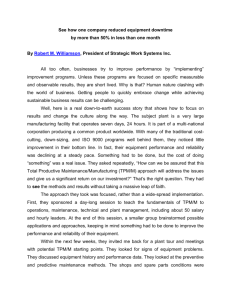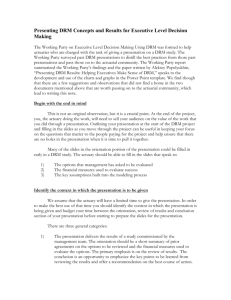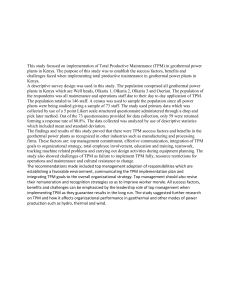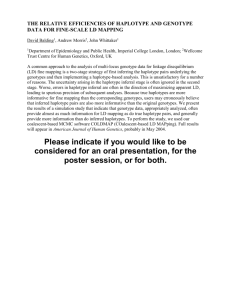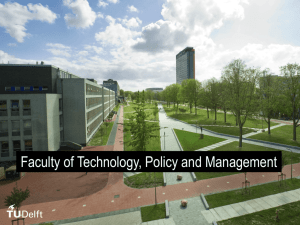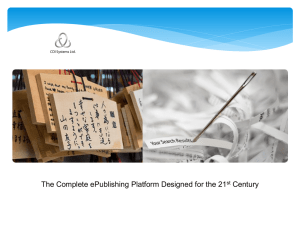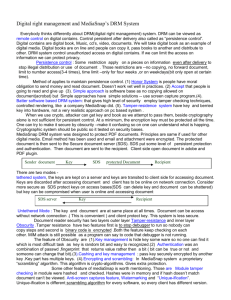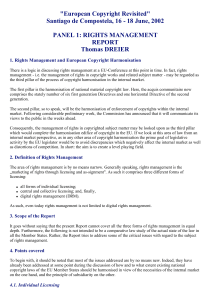TPMs/DRMs How to regulate them?
advertisement
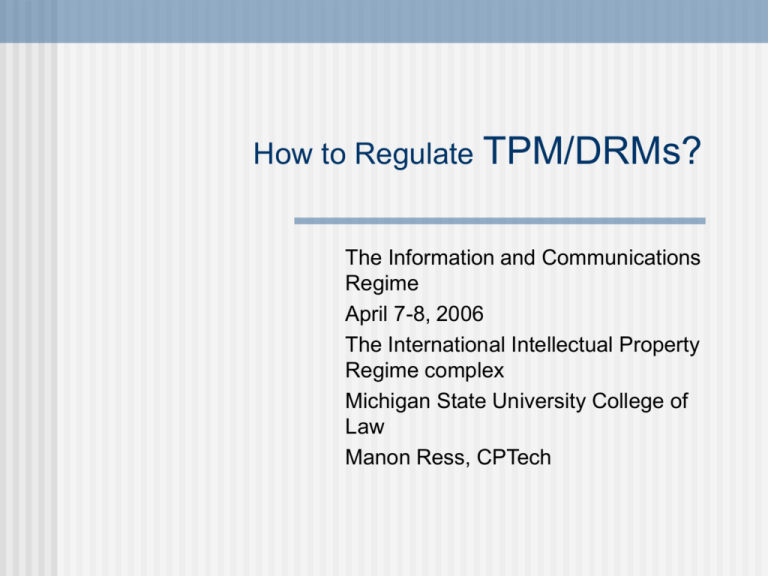
How to Regulate TPM/DRMs? The Information and Communications Regime April 7-8, 2006 The International Intellectual Property Regime complex Michigan State University College of Law Manon Ress, CPTech OUTLINE Background What is protected legally? Hacking, contracts and expectations Some implementations Rethinking the legal regime for TPM/DRM Proposal Background digital information technologies has created uncertainly re access to knowledge goods it is now inexpensive (free?) to copy distribute works to millions of persons there's a large degree of insecurity among publishers or producers rise of new efforts to control or limit the copying, or uses, of creative works and data. TPM/DRM characteristics operate with or without standardization depending upon the nature of the publishing standardized for recorded performances of music or motion pictures but not for all uses if effective, provide possibility of managing works in ways not possible in print or analogue (eliminate all unauthorized copying or uses of works) system of private rules for the use of information designed by and for publishers to control Description strategy for controlling the uses of the works is both technological and legal. It involves effort to promote both public and private standards combination of (1) effective technological locks on uses of information, (2) a system of tracking and controlling uses, and (3) legal prohibitions against anti-circumvention of (1) and (2). What is protected legally? 1996 WIPO Copyright Treaty (WCT) & WIPO Performances and Phonogram Treaty (WPPT) NOTE: These treaties are unusual: that they did not seek to harmonize global laws on copyright, but rather created new and untested standards to be implemented by national governments These treaties require that member states: “provide adequate legal protection and effective legal remedies" against the circumvention of effective technological measures and against any person knowingly removing, altering, distributing… these obligations require a legal environment to protect the TPM/DRM regime Issues Hacking is possible so success in limiting access depends upon actions of governments to prohibit anticircumvention Contracts that should be enforced by governments? Expectations are changing but there is Public Interest in Unauthorized Uses of Works Knowledge goods are “non-rival in consumption” and can become (as defined by economists) public goods (to everyone at no cost) More Issues for Knowledge Goods K.G. (2) But unlike pure public goods (national defense), it is both possible and common to limit access. Scarcity of k.g. is a function of private and government efforts to protect barriers to access. Justifications: k. g. will not be created without barriers to access, or a moral or ethical obligation to give creators/publishers control over the use of their works More Issues for Knowledge Goods K.G. (3) types of k. g. highly heterogeneous in character & costs syllabus, publishing of laws and regulations, reports of the activities of government agencies etc. feature films, design of computer semi conductor chips, the creation and maintenance of certain databases etc. These are less likely to be undertaken without an expectation of revenue from the sale of the work Implementations in high-income countries US: the Digital Millennium Copyright Act, known as the DMCA (1998). As the first model, it is influential. • basic approach was to provide for the automatic protection of all TPM/DRM regimes, but to provide for limited areas where there exceptions to the anti-circumvention rules. EU’s system includes an "Internet Copyright Directive," or Directive 2001/29/EC , as well as other directives that set out the regulatory framework for TPM/DRM regimes. Implementation is not harmonized. Japan, Australia …and Canada soon Implementations in Developing countries 58 contracting parties to the WCT and 57 to the WPPT largest numbers of countries that have signed the treaties are from the developing world, including many countries with very limited use of the Internet or computer Five are defined by the UN as Least Developed Countries (LDCs), including Burkina Faso, Guinea, Mali, Senegal and Togo In 2004, nine of the WCT members had a per capita gross national income (GNI) of less than $1,000, and more than half (31) had per capita incomes of less than $3,000 per year. response to trade pressures from the United States or other high-income countries & mimic the legal approaches now used in high-income countries Rethinking the legal regime for TPM/DRM Many concerns but at the core: predictable & harmful impact of having private parties -- publishers -determine the default rules for access to k.g. The starting point is that the TPM/DRM itself must be protected from circumvention, independent of the work that is protected, and without regard to the likely impact on the uses of the works. Let's explore alternative ways of regulating the TPM/DRM regimes more consistent with protecting access to knowledge goods Proposal No automatic legal protections to TPM/DRMs but system requiring vendors and users to register to apply for protection against circumvention Need to explain how the regime will respond to legitimate uses of the works under public (rather than private) standards for access Legal protection would not be forthcoming, until the regulator was satisfied that regime does not inappropriately restrict access to the work Registration Instead of providing automatic protection, a system requiring vendors or publishers to register It could involve a fee It could involved negotiations to protect user rights It could be for specific uses Conditions Obligations for protection of copyrighted works are different from obligations regarding TPM/DRM The “lock” does not need broader rights Not every use of copyrighted goods Not use that are against public policy Conditions (2) Protection should not be extended to DRM on works not protected by copyright Protection only for interest of the CR owner Term can be shorter Lock only when needed to protect legitimate interests of CR owner Conditions (3) DRM is a contract and should be subject to public policy before being enforceable Review of DRM can be different from one for TPM For ex. DRM that prohibit private copy, time shift Major concerns for non-negotiated contracts Fora New systems could be proposed and implemented in countries willing to experiment and promote policies of protecting access to knowledge Specific area Entire copyright field? Special area Public science where norms re access are esp. important Publicly funded science based upon a different economic model Examples in copyleft type rules see HapMap licenses EXCERPTS FROM THE ORIGINAL HAPMAP TERMS AND CONDITIONS FOR ACCESS TO AND USE OF THE GENOTYPE DATABASE 2. You may access and conduct queries of the Genotype Database and copy, extract, distribute or otherwise use copies of the whole or any part of the Genotype Database's data as you receive it, in any medium and for all (including for commercial) purposes, provided always that: a. by your actions (whether now or in the future), you shall not restrict the access to, or the use which may be made by others of, the Genotype Database or the data that it contains; b. in particular, but without limitation, i. you shall not file any patent applications that contain claims to any composition of matter of any single nucleotide polymorphism ("SNP"), genotype or haplotype data obtained from the Genotype Database or any SNP, haplotype or haplotype block based on data obtained from the Genotype Database; and ii. you shall not file any patent applications that contain claims to particular uses of any SNP, genotype or haplotype data obtained from the Genotype Database or any SNP, haplotype or haplotype block based on data obtained from, the Genotype Database, unless such claims do not restrict, or are licensed on such terms that that they do not restrict, the ability of others to use at no cost the Genotype Database or the data that it contains for other purposes; and . . . See http://www.hapmap.org/cgi-perl/registration Conclusion A new “default setting” is needed Nothing is protected unless registration is approved by public authorities TPM/DRM as exceptions for which enforcement depends on uses and effects For more information Consumer Project on Technology www.cptech.org Tel.: 1 202 332 2670 Manon.ress@cptech.org
